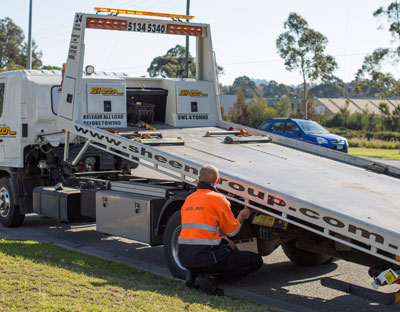If you will operate tilt trays, you would know that doing so in a safe manner is paramount. Anyone who uses loading and unloading vehicles has to be well-informed and proficient. This way, you will be able to avoid work mishaps.
Such vehicles include self-propelled and skid-mounted equipment, among others. Read this tutorial and know what to do and what not to do in using these devices.

Inspect
Before anything else, it is critical to do a complete check of the equipment. An operator entrusted with using a tilt tray should be able to examine equipment. This is a minimum requirement. There should also be regular maintenance from a certified technician. This is aside from the regular equipment inspections. Before using the tilt tray, make sure the slings and lifting attachments are in good shape. The other fundamental parts should also be in excellent working order.
It is the operator’s job to recognize visual issues. S/he should be able to do the following:
- Ensure that the truck has the proper slings and attachments.
- Use each piece of attachment equipment on the vehicle in a safe manner.
- Use the load’s safest anchor locations.
- Discard any damaged equipment. Other operators might be unaware and still use them.
Winch and winch ropes
Always inspect winch attachments since these are required in operating a tilt tray. Get rid of them if there are obvious damages or if they become too loose. It will be safer to get new ones. Be on the lookout as well if the hook attachments and winch ropes are broken or worn out.
Chain grabs and shorteners
Look at the chain grabs. Are they the same size as the chain you are using? Be sure to check that they are. Examine these parts and note indications of wear and tear or damages. Before utilizing these attachments, the chain shortener’s load limit should be reduced properly.
Hooks and chains
Look for a safety catch on the hook and make sure the mouth isn’t open. Check for any damage, including any crack or bend. A trained technician will be able to help you in this area if you are not sure. The chain should maintain its oval form, with no bends or twists. Examine the bearing surface for evidence of wear and tear. If you use worn-out chains, these will pose danger. Change them right away if the links are already elongating.
Web belts
Inspect web belts for damaged stitching or cuts in the webbing. If you find even one, call a skilled technician so s/he can do the necessary next steps.

Attach
Attachments
To guarantee that the weight limit of an item does not exceed the force of the winch, it’s critical to choose the right attachments. Before operating the tilt tray, pay special attention to the hooks, winch ropes, fittings, and slings.
Adjusting the hydraulics is one technique to restrict the maximum force exerted by the winch. A qualified technician does this step. Make sure that the force applied by the winch is always less than the attachment’s operating load limit. Why? Here are the reasons:
- Visual input alone might make it difficult for the operator to establish how much force is being applied to the attachment.
- If there are obstacles, the winch’s force might abruptly increase. This might go over the attachment’s weight limit before the equipment can be switched off.
- Between the attachment and the winch drum, the weakest point might fail. This might also result in load failure.
It will not be a good idea that the attachment equipment will only withstand the draw of a hydraulic winch. This applies when weights are about 15 tonnes. The recommendation is to limit the pull of the winch.
Drawbars
You need to use a drawbar if you want to safely load and unload a marine container. You may use this solid coupling instead of chain slings. This eliminates the abuse of chains and other attachments. When slings are not an option because loads need an excessive angle, drawbars are a great alternative.
Snatch blocks
Using a snatch block with a winch rope will increase the winch pull and double its limit. To enhance its pull, wrap the rope around the pulley and hook while being linked to a stationary location.
Ejector devices
Workers can quickly install ejector devices because of hydraulic rams. You may install ejector devices into most tilt tray trucks to make unloading faster and safer. Pro tip: Before using an ejection device, always read the manufacturer’s instructions.
Operate
Positioning the back of the vehicle near the cargo is the best method to load a tilt tray. There should just be enough room for the tilt tray to move in front of it. The winch rope is attached with a sling, and the hydraulic controls allow the operator to draw the weight onto the vehicle. Any error might endanger the load and the workers’ safety. This is why the operator needs to have adequate competence and skills.
An able operator will be observant enough to detect possible problems. S/he will be confident enough to stop the operations if the equipment is at risk of failing. Also, s/he should adjust their operations in response to unexpected loads, changing weather, and other environmental considerations. The goal of all these pointers is to assist you in properly and safely operating tilt tray trucks.
